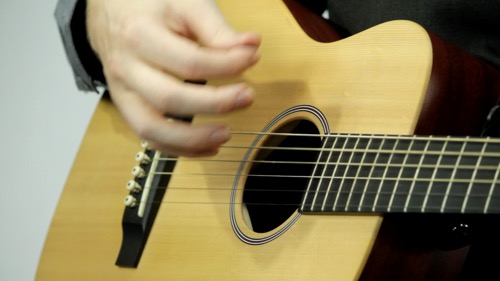Basic Guitar Strumming Patterns Lesson

Let's talk about some basic approaches to strumming the guitar.�
The first thing you've got to do is to play in time. It's much better, even at the very advanced level, to play a simple rhythm in correct time than to play a more complicated rhythm with inaccurate time.�
For that reason, it's a great idea to practice with the metronome. You probably don't want to, but it can really help.�
First, we're going to strum a constant flow of even beats, which are grouped into units of four. Because of this grouping, they're called quarter notes. I'm going to use a G chord for this demonstration.��
Now, we're going to divide those beats by two, resulting in eighth notes.
Now, let's imagine that these eighth notes form a grid. By removing some of those notes and replacing them with rests, or silence, we can create a lot of different rhythms.
I'm going to remove one at a time until I end up with a more simple strumming pattern.
First I'll set a metronome to 100 beats per minute. Here is the patterns.�
First I'll remove the fifth one.
Then the fifth and the eighth one.
Then second, fifth and eighth.
And finally, second, third, fifth and eighth.
So you can see many rhythms can be built from this basic grid.
Try it yourself--use a metronome. And maybe come up with some of your own rhythms.
Guitar Strumming Technique
- The underlying technique for strumming the guitar is a constant down-up cyclical motion.
- The wrist is loose, and the pick is used to brush the strings very lightly.
- A thin pick is helpful in the beginning. A relaxed grip will allow any pick to brush past the strings.
- Don’t dig the pick too deep into the strings. Its edge grazes the surface.
About Guitar Strumming
Not sure how to approach learning guitar strumming patterns? Don’t worry, it’s fairly straightforward once you learn to hear the underlying pulse and play beats corresponding to that.
You can play many different patterns just by playing eighth note rhythms.
This strumming exercise begins with one chord per beat. Then the beat divides into two, for a total of eight strums per four-beat measure. From there, we can omit or drop out certain patterns to invent new variations.
Try strumming through these patterns with a single chord, such as E major. Maintaining the consistent down/up cyclical motion is key to keeping good time.
Strumming is ordinarily done with a pick. A thin pick is a great choice for beginners. Note that it’s not important for the pick to touch on all strings each strum. It might only touch some of the low strings on the way down and some of the high strings on the way up. Far more important is to have a smooth, back-and-forth motion and an accurate rhythm.
Picks recommended for learning strumming: Dunlop .38mm Nylon Pick[?]Affiliate Link.
Beginning Strumming Patterns
Quarter notes
Strum once per beat, on the beat.

Eighth notes pattern 1
Strum twice per beat, on the beat and off the beat.

Eighth notes pattern 2
The pattern consists of 8 eighth notes. Skip over eighth note #5 by strumming the air instead of the guitar.

Eighth notes pattern 3
The pattern consists of 8 eighth notes. Skip over eighth note #5 and #8 by strumming the air instead of the guitar.

Eighth notes pattern 4
Skip over eighth notes #2, #5 and #8 by strumming the air instead of the guitar.

Eighth notes pattern 5
Skip over eighth notes #2, #3, #5 and #8 by strumming the air instead of the guitar.
Note that the second line is the same pattern, but notated in a more simlpe way.

Hear All Examples
Key Tasks
- Practice the patterns until you can play them all in time—with a metronome.
- For more strumming exercise, review our other strumming pattern lessons, which can be found in the musicianship section under the “rhythm” category.
 As the creator of Hub Guitar, Grey has compiled hundreds of guitar lessons, written several books, and filmed hundreds of video lessons. He teaches private lessons in his Boston studio, as well as via video chat through TakeLessons.
As the creator of Hub Guitar, Grey has compiled hundreds of guitar lessons, written several books, and filmed hundreds of video lessons. He teaches private lessons in his Boston studio, as well as via video chat through TakeLessons.